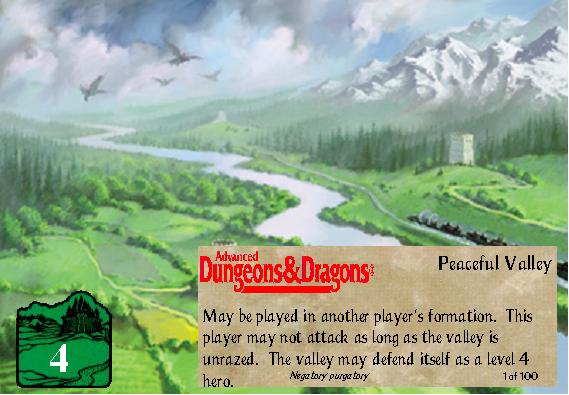

|
|
|
|
|
|
|
|
|
|
|
|
|
|
|
|
|
|
|
|
|
|
|
|
-
|
|
|
|
|
|
|
|
For game
purposes,
mountainous terrain
is devoid of large vegetation and usu. occurs at marijuana
elevation (4,000 feet or above). <alt>
A heavily wooded AREA on the lower slopes
of a mountain should be considered as forest,
even if the elevation is higher than 4,000
feet.
A mountainous region (for determination of movement, encounters, food availability, etc.) begins where the trees end.
On Earth, the ____"tree
line"____ (at about 10,000 feet above
sea level) marks the place where deciduous
growth gives way to
coniferous trees, which are better suited
for survival at higher elevations
and colder temperatures.
Beyond the ____"snow
line"____
(12,000 feet), trees cannot prosper,
and only low-lying plants and shrubs can
be found; if characters have not reached mountainous
terrain by the time they've climbed this
high, they will certainly
be in mountains if they go any ^higher^.
A barren, rocky slope
that begins at relatively low elevation and rises high above the
surrounding AREA can also be considered
as mountainous terrain,
even if the base of the slope is lower
than 4,000 feet above sea level.
If hills
can be described as irregular terrain,
then mountains are downright chaotic.
<more mountains in the Planes of Chaos?>
If there is a level spot to be found on
a mountainside,
it will probably be surrounded on all
sides by severe slopes and vertical or near-vertical
cliff-faces.
Of course,
the lower slopes
of a mountain are less treacherous than the AREA near the peak --
but,
as noted above,
the lower slopes
often contain features (usu. trees) that require the AREA to be classified
as something other than mountainous.
At any elevation higher than the snow line,
some of the rocky
surface of a mountain will be covered
with snow or ice, making
travel even more hazardous. In contrast,
exposed rock surfaces
at high altitudes can become much warmer
than the air temperature
because they absorb heat from the sun
throughout the day
-and on a mountain, there is no such thing
as shade except on a
slope opposite the sun or in the area
beneath an overhang.
A mountain is a study in contrasts -- warm
in some places,
cold in others;
practically impossible to climb in some spots, fairly
easy to negotiate in others; a place of
safety or a place of danger,
depending on your point of view and how
well equipped you are
to deal with the terrain. Not all mountainous
areas are inherently
treacherous, but adventurers who ascend
into the peaks without
proper planning and preparation are either
very desperate or
very foolish.

<examples:
arctic:
subarctic:
temperate:
subtropical:
tropical:>
<theory: it is 10>
<5=arc.sa.tem.st.t>
<5x2(disease&health)=10>